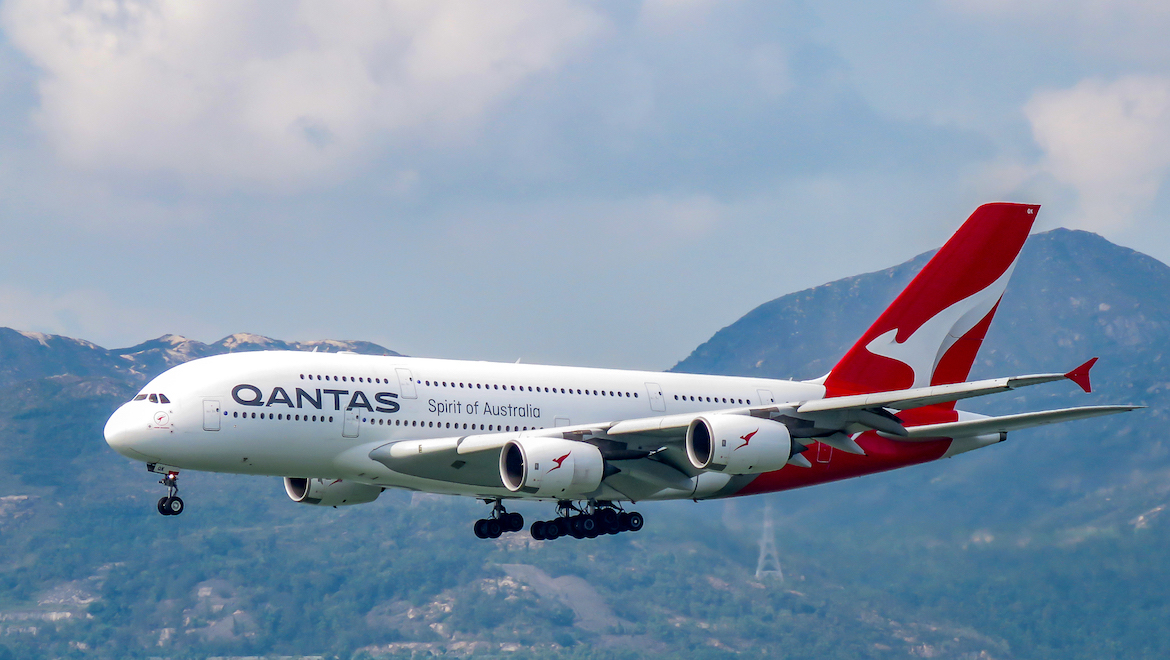
Qantas has welcomed back its first Airbus A380 featuring a refurbished cabin including new business class seats, a new lounge on the upper deck and more premium seating.
The A380 VH-OQK, which had been in Dresden, Germany since the middle of July, returned to service on September 30 when it operated the QF 2 from London Heathrow to Sydney via Singapore.
After arriving in Sydney on Wednesday morning, the aircraft was presented to media and invited guests in Hangar 96 at Qantas’s Mascot jet base.
In addition to new business seats that were similar to what was already on Qantas’s Airbus A330 and Boeing 787-9 fleet, the reconfigured A380s also had a higher number of premium seats.
While the total number of seats has been increased by one to 485, the split between the four cabin classes has changed.
First class was unchanged at 14 seats, while the business cabin has been expanded to 70 seats, from 64 in the old configuration.
There was a big increase in premium economy from 35 to 60 seats, while the economy cabin was being cut by 30 seats to 341 seats.
The upper deck has been reconfigured to only business and premium economy cabins, while first and economy will be on the lower deck.

Under the new configuration, the percentage of premium seats on Qantas’s A380s rises to 30 per cent of all seats – the same as on the three-class 787-9s featuring business, premium economy and economy – compared with 23 per cent in the old configuration. (See chart below.)
Qantas has said previously a more efficient use of space allowed the airline to boost the number of premium seats on board the aircraft.
The reconfiguration program, first announced in August 2017, was being managed by Airbus, which said at the time the new interior took advantage of the A380’s large floor area to “most efficiently embody Qantas’ latest seat products for business class and premium economy”.
Qantas said the mid-life refurbishment program for its A380s would take about eight weeks per aircraft. A further two A380s were expected to be refurbished in 2019, with all 12 expected to feature the new products by the end of 2020.
The Flying Kangaroo’s first A380, VH-OQA Nancy-Bird Walton is 11 years old, having arrived in Sydney on September 21 2008. Eleven more followed in the next three and a bit years, with the 12th and youngest A380, VH-OQL Phyllis Arnott, delivered in December 2011.
“The A380 is a crucial part of our long-haul fleet and this upgrade program will see customers enjoy everything the aircraft has to offer for years to come,” Qantas chief executive Alan Joyce said in a statement on Tuesday.
“It also provides an increase in business and premium economy seating to help match the demand we’re seeing on our long-haul routes.”
“Working with Airbus, we’ve been able to use the cabin space more efficiently and improve the economics of the aircraft while also providing a better experience in every part of the aircraft.”
Aircraft |
First |
Business |
Premium
|
Economy |
Total |
Percentage premium
|
|
Airbus A380 (old configuration) |
14 |
64 |
35 |
371 |
484 |
23% |
|
Airbus A380 (new configuration) |
14 |
70 |
60 |
341 |
485 |
30% |
|
Airbus A330-300 |
0 |
28 |
0 |
269 |
297 |
9% |
|
Airbus A330-200 (V1) |
0 |
28 |
0 |
243 |
271 |
10% |
|
Airbus A330-200 (V2) |
0 |
27 |
0 |
224 |
251 |
11% |
|
Boeing 747-400/400ER |
0 |
58 |
36 |
270 |
364 |
25% |
|
Boeing 787-9 |
0 |
42 |
28 |
166 |
236 |
30% |
Source: Qantas










